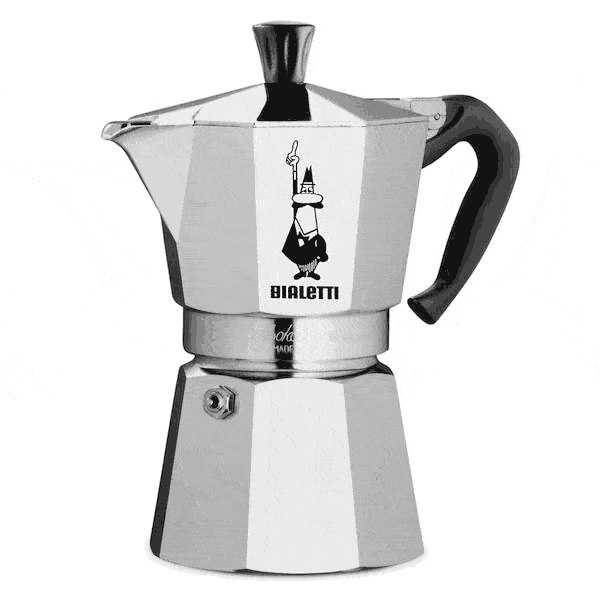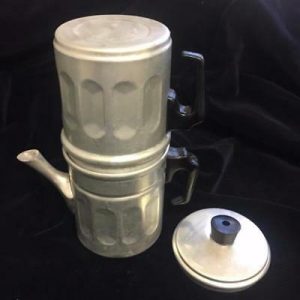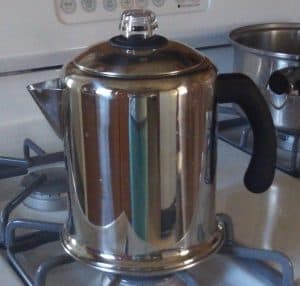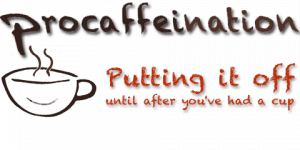
We all have our favorite ways to turn coffee beans into our beverage of choice. Here is a list of twenty-four ways to brew coffee with brief synopses of the methods. Follow the links to posts that do a deeper dive on the individual method. If you want to know more about a specific method of brewing, drop me an email and I will do that one first.
In a jam?
Super Easy Ways to Make Coffee without a Coffee Maker
Caffetierra / Moka Pot / Espresso Pot

The word
Filter Methods
A very common way to brew coffee is to, in essence, steep the ground coffee to produce the liquid and then filter out the grounds, leaving only the black goodness. The filters are most commonly made of paper, but they are also available in fabric – usually hemp – and finely woven metal – usually a gold plated mesh.
Automatic Drip
This is the most common way coffee is brewed in America. At home, one can often find a “Mr. Coffee”-type appliance that brews an acceptable cup of coffee and in offices, you can find a rugged machine that might make an OK cup but doesn’t because the coffee service provides only the cheapest coffee available. In function, an automatic drip coffee maker heats and delivers the appropriate measure of water into a filter receptacle containing the ground coffee and drips it into a pot. Often the machine has a heating element to keep the coffee hot which can be a bad thing if the coffee becomes burnt – YUCK!
Cold Drip
There are a number of cold drip systems that use various bits of apparatus. What they all boil down to (although, there is no boiling involved!) is slowly melting ice dripping into a bed of coffee that is filtered into a receptacle.
Neapolitan Macchinetta

An old school brewing method from Naples, Italy, in which ground coffee is secured in a two-sided strainer at the waist of the pot between two closed compartments. Brewing water is heated in one compartment, then the pot is flipped over. This allows the hot water to drip through the coffee into the opposite compartment which has a spout for pouring. It is also sometimes known as a Flip-Drip and sometimes just a Macchinetta,
Pour Over
This style of brewing consists of pouring hot water over ground coffee in a
Espresso
The method of espresso brewing describes the process in which hot water of 202º F (94.4 C) is forced under 9 atmospheres of pressure through a compressed bed of finely ground coffee.
This method of brewing coffee comes from Italy but don’t ask for one there! In Italy, espresso is a technical term which describes the method, not the drink. Instead, just order “un caffé” and you will get the drink you are looking for.
Piston Espresso Machine
A manually operated espresso maker whereby the barista uses a lever to actuate a piston that pushes hot water through the ground coffee. This is the derivation of the term “pulling a shot.”
Additionally, there are two sub-types of piston machines: manual piston and spring piston. The manual piston design requires the operator to “artistically” push the water through the grounds at the required pressure. In the spring piston design, the lever tensions a spring which then delivers the precise amount of pressure for the espresso. Less art but more precision.
Pump Espresso Machine
An espresso machine that uses a motorized pump to force brewing water at the appropriate pressure through the bed of ground coffee. Again, not as artful but consistent.
Capsule Type Espresso Machine
An automatic, single serving machine such as those made by Keurig, Nespresso, and Lavazza, which is designed to use a prepackaged plastic or metal container of coffee to brew a single cup. These types of machines utilize a pump to achieve the high pressure necessary to pull a proper espresso.
Steam Espresso
Basically, the electric version of the stovetop Moka pot. Steam is used to push hot water and steam through the bed of finely ground coffee. The problem for purists is that steam only goes to 1.5 atmospheres of pressure, far short of the 9 atmospheres required to bre a proper espresso.
Pod Type Espresso Machine
A single serving coffee machine like the Phillips Senseo, that utilizes coffee encased in a teabag-like pod or pad. Although it operates through the power of steam, and so at a lower pressure, it employs a secondary frothing chamber to create a nice, frothy crema.
French Press / Plunger Pot
Method of brewing where hot water is poured over coarsely ground coffee and after waiting the appropriate time, a plunger pushes the ground coffee through a filtering mesh screen to the bottom of the carafe, separating the grounds from the brewed coffee.
Details of the process can be found at
https://procaffeination.com/french-press-plunger-hard-to-push/
Instant
Coffee that can be prepared in a rapid fashion by adding hot water and stirring. The plusses are that it is quick to make and cleanup is a breeze – no grounds!
Coffee Crystals / Coffee Powder
Freeze-dried coffee is made by extracting the flavors and aromas of the coffee using
Cold Brew Extract
Coffee is ground and steeped in cold water (see Cold Water Method) for up to 12 hours. The resulting brew is strained and the concentrate saved. To make a cup for drinking, just add hot water.
Percolator

This is a method of coffee brewing in which boiling water is forced up through a tube and then filters down through a bed of ground coffee. The resulting brew tends to be bitter, as over-extraction is likely.
Microwave Brewer
An unnecessary plastic object that invariably makes a mess out of your microwave. Combines the worst parts of percolation with the illusion that it is going to be fast and easy. Any time that you might potentially save in the brewing process is
Steeping
Coffee Bags
A single-serving method for your morning cup. Just add hot water. I mean, when you think about it, it is coffee inside of a filter.
Open-Pot Method
Brewing coffee by steeping (not boiling) in an open pot is the oldest method of coffee brewing. You can thank the Sufi monks that wanted to stay awake for their late-night prayers for that. After brewing, the grounds are allowed to settle and are separated from the brewed coffee by pouring carefully. Alternatively, the resulting brew may be strained.
Cezve (Turkish coffee) / Briki (Greek coffee)
A specific variation on the open-pot method, this coffee is brewed and served in a small, conical pot with a handle and is highly sweetened and/or spiced.
Cold Water Method
You can try setting your ground coffee out overnight to steep and heat up the strained brew in the morning.
Boiling
Method where whole bean or ground coffee is boiled in water to extract the flavors. It will be a bitter brew. This largely seems to be either a cultural thing or a method of necessity. I had some exceptionally nasty coffee one time when I went dog sledding in Norway.
Cowboy Coffee
An improvised brewed coffee made while camping. It’s not a really great way to brew, but sometimes you just need some coffee. Here are two recipes you can try:
- Step One: Boil water in some sort of container over a low part of your campfire.
- Step Two: Add ground coffee and stir with a clean stick.
- Step Three: When it boils, add a pinch of salt. This breaks the surface tension of the bubbles, reducing over boil, and cuts down on the bitterness.
- Step Four: Toss in an eggshell. This also reduces the surface tension and helps the grounds settle to the bottom.
- Step Five: Pour into your cup with care to reduce the number of grounds into your cup.
or as my old pal, Mike, would have it:
“Dried cherry [i.e. raisins (dried coffee beans with the skin still on)] ground in a gold pan (you know, just in case you are a prospector, too) with the butt of a six shooter then roasted over the camp fire before boiling; then drunk out of a metal cup that burns your lips.”
Vacuum Pot / Siphon
This brewing method was originally patented in 1841 and called the French Balloon. It involves two chambers where vapor pressure and partial vacuum pull water through the ground coffee.
Tim says…
This is, bar none, my favorite brewing method, but it is not my usual one, the reason for which you will soon understand. Boiling water in a sealed pot is forced into another chamber that holds the ground coffee. When the heat is removed from the sealed pot the brewing water is drawn through the ground coffee by means of the partial vacuum created by the cooling of the sealed pot. It’s like a science experiment and makes an exceptional cup of coffee but it is a pain in the neck to clean the apparatus and easy to break the sealed pot by moving it off the burner in a panic because you accidentally boiled off all the water and then hit a drop of water on the stove which cracks the glass. Hypothetically.
Well, there you have it. Enough ways to brew coffee to keep you busy for the whole month. Let me know your favorites, and even your least favorite, in the comments. I would love to know!

